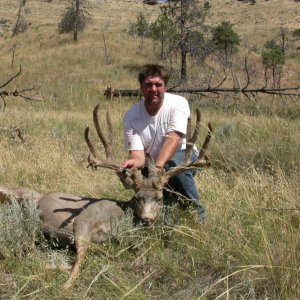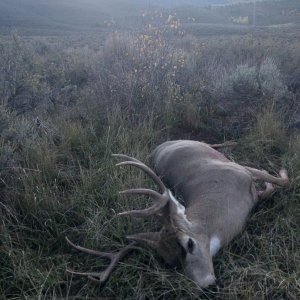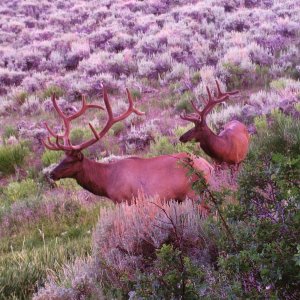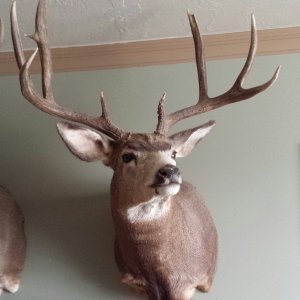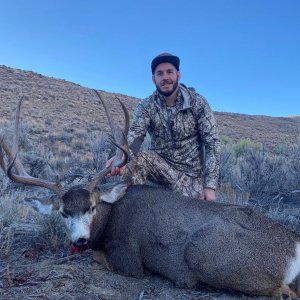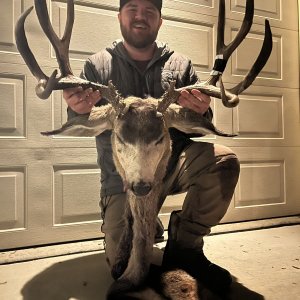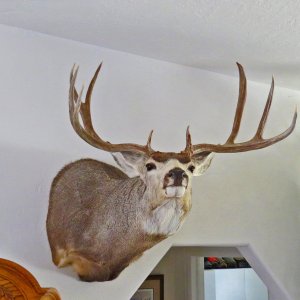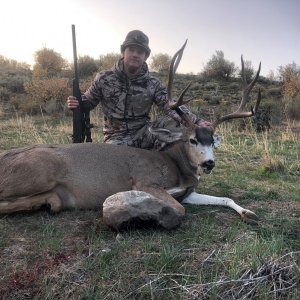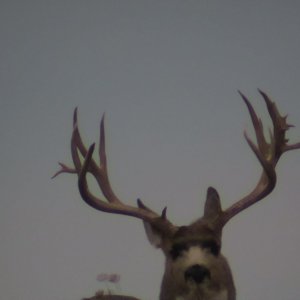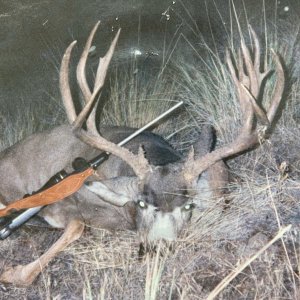You should upgrade or use an alternative browser.
A real spike unit trophy
- Thread starter ridgetops
- Start date
Sallaberry
Very Active Member
- Messages
- 1,035
Old Cowboy
Active Member
- Messages
- 189
what's the definition of a legal spike?Here's a bull that has the makings of a great spike unit trophy, as long as he doesn't branch out on that dropper / spike side.
Hopefully I'll run across him this October since he's actually on an any bull unit. View attachment 46391
littlebighorn
Long Time Member
- Messages
- 5,409
ridgetops
Very Active Member
- Messages
- 2,878
If it doesn't fork above it's ear on at least one side, then it's a legal spike.what's the definition of a legal spike?
yoteduster
Very Active Member
- Messages
- 2,309
ridgetops
Very Active Member
- Messages
- 2,878
I'm going to check my camera in the next couple weeks. Hopefully he'll be on it again and we can see how he turned out.That's A cool bull..time will tell but I expect he'll fork out before he's done growing
yoteduster
Very Active Member
- Messages
- 2,309
elkassassin
Long Time Member
- Messages
- 39,584
ridgetops
Very Active Member
- Messages
- 2,878
Is that legal?You Could Pack Your Cordless SAWZALL & Trim Him Down to a Spike on that one side!
elkassassin
Long Time Member
- Messages
- 39,584
But Remember!
Nothing In TARDville Illegal Ever Happens!
Is that legal?
travishunter3006
Very Active Member
- Messages
- 2,065
yes. A legal spikeno a legal spike...
one antler beam with no branching above the ears. Branched means a projection on an antler longer than one inch, measured from its base to its tip (R657-5-
As of right now there are two antlers longer then one inch above the base.
Not a Spike
Vanilla
Long Time Member
- Messages
- 5,456
A “spike bull” means a bull elk which has at least
one antler beam with no branching above the ears. Branched means a projection on an antler longer than one inch, measured from its base to its tip (R657-5-
As of right now there are two antlers longer then one inch above the base.
Not a Spike
You are correct that one antler beam has two antlers branching above the ears that are longer than 1 inch. However, the other side appears to not have that. Meaning…spike bull under Utah definition.
Everyone is correct that you have to wait and see what that back end on the left side does, but it’s got a shot.
elkantlers
Long Time Member
- Messages
- 3,895
The bull above would be considered a " Legal spike" under Utah rules at the time of the picture.
Moral of the story: Know the rules.
I tend to agree with you because broken bulls get shot when they really shouldn’t. I passed a last day general muzzleloader bull a couple years ago that was broken just above the eye guard. He would have been within the rules but knowing he would be a solid 330 bull had he not broke, I let him walk.So the brow tine is not considered a projected antler branched off the main bean measured from the base to its tip??
Could be wrong but that’s how I’m reading it...
I personally wish they’d change it to a legal spike having no browtines.
Elkslayer2015
Active Member
- Messages
- 881
That bull that ridgetops has camera is legal on a spike unit he's a young bull I'll bet he forks though and I'll bet he has great potential to be a big bull in another 2 to 3 years....
Is that the Moral of the story Mr Richard Head...Brow tines branch below the ear.
The bull above would be considered a " Legal spike" under Utah rules at the time of the picture.
Moral of the story: Know the rules.
Some people show their true colors on here for sure...
elkantlers
Long Time Member
- Messages
- 3,895
LOL. Why go to insults? That speaks Volumes of your character or lack there of.Is that the Moral of the story Mr Richard Head...
Some people show their true colors on here for sure...
I know the rules and would kill that bull given the chance.
You, Not so much. So ya, knowing the rules matter.
travishunter3006
Very Active Member
- Messages
- 2,065
See any branching of his left antler above the ear there bud?A “spike bull” means a bull elk which has at least
one antler beam with no branching above the ears. Branched means a projection on an antler longer than one inch, measured from its base to its tip (R657-5-
As of right now there are two antlers longer then one inch above the base.
Not a Spike
Elkslayer2015
Active Member
- Messages
- 881
I hope I get this right what they are meaning There are two bases when scoring.A “spike bull” means a bull elk which has at least
one antler beam with no branching above the ears. Branched means a projection on an antler longer than one inch, measured from its base to its tip (R657-5-
As of right now there are two antlers longer then one inch above the base.
Not a
one is the overall beam length which is from the base of the Burr to the back end of the antler.
Now when you’re measuring your G1 G2 G3 etc. the main beam is the base of that horn if that makes sense and that’s what they are referring too..
Vanilla
Long Time Member
- Messages
- 5,456
So the brow tine is not considered a projected antler branched off the main bean measured from the base to its tip??
Could be wrong but that’s how I’m reading it...
Yes, you are wrong. The branch has to be above the ear to count. Utah's spike definition is kind of silly, if you ask me, but it is still the definition.
hornkiller
Long Time Member
- Messages
- 4,269
Just photo shop a WL tramp stamp on the pic and you will be golden!Is that legal?
ridgetops
Very Active Member
- Messages
- 2,878
I ckecked my 5 cameras a couple weeks ago and I have them spread out about 1/2 to one mile apart. Nothing. Maybe he'll show back up in August or September.Anymore pics of him @ridgetops
travishunter3006
Very Active Member
- Messages
- 2,065
Good. More for us that know how to read.I wouldn’t take the chance
Katoom
Active Member
- Messages
- 609
Granted, I am not from Utah, I am not a lawyer and this does not constitute legal advise……so this is ultimately worth SQUAT.
travishunter3006
Very Active Member
- Messages
- 2,065
It really is simple…. Does it branch above the ear?….. that’s it. Don’t make it into something it isn’t. It’s simple for a reason.Aren’t the entire antlers above the ears, as in, higher on the head than the attachement of the ears? I could see if it said “above the tips of the ears when held vertically” or something more precise. that is one weird definition (using ears to define antlers) and one risky/expensive mistake if wrong.
Granted, I am not from Utah, I am not a lawyer and this does not constitute legal advise……so this is ultimately worth SQUAT.
Vanilla
Long Time Member
- Messages
- 5,456
It really is simple…. Does it branch above the ear?….. that’s it. Don’t make it into something it isn’t. It’s simple for a reason.
Agreed. People try to make the spike definition WAAAAY more difficult than it really is. Now, there are antler configurations that are really close calls just because of how the antler is, and there are some that should give you pause to make sure it meets the definition, but the definition is quite simple.
Katoom
Active Member
- Messages
- 609
Maybe, legally. So 5x3 with a brow tine and dropper and probable future trophy potential gets shot. Fine. But in this day and age of limited game and max pressure, maybe the definition should actually be re-worked to describe a spike that we all know and would describe as a spike, as in, an elk (typically a yearling) with unbranched antlers. Hows that for a simple, accurate, and agreeable definition.Agreed. People try to make the spike definition WAAAAY more difficult than it really is. Now, there are antler configurations that are really close calls just because of how the antler is, and there are some that should give you pause to make sure it meets the definition, but the definition is quite simple.
In the meantime, maybe call them Loophole Units.
Vanilla
Long Time Member
- Messages
- 5,456
Adding ( Above the tip of the ear ) in the definition would definitely make it clearer.
View attachment 49581
The “ear” encompasses the entire ear, including the tip. I personally don’t think that makes it any more clear. Like I said, we try way too hard to make this difficult when the definition is really quite simple.
And Katoom, yes, the definition allows for something that YOU think is not a traditional spike to be shot as a spike. I think many that helped craft the definition the way it is would argue with you that the 5x3 you described had “future trophy potential” and would love to see that bull out of the gene pool. For me…I really don’t have an opinion on what the definition SHOULD be, I’m simply commenting about what the definition currently IS.
If the state redefined it to be as you described, I’d follow that rule the same as I would follow this one when I hunted spikes. A “spike bull” for lawful hunting purposes is simply what the state defines as a spike. Not what we think it SHOULD be.
brutus54
Active Member
- Messages
- 858
Some people say it’s clear and easy to read and understand. We’ll It all depends on who’s reading it. As to Katoom’s point in this picture it appears to me that all the antlers are above the ears. So it all depends on how you look at. Be it right or wrong definitely makes for a lively discussion.?Aren’t the entire antlers above the ears, as in, higher on the head than the attachement of the ears? I could see if it said “above the tips of the ears when held vertically” or something more precise. that is one weird definition (using ears to define antlers) and one risky/expensive mistake if wrong.
Granted, I am not from Utah, I am not a lawyer and this does not constitute legal advise……so this is ultimately worth SQUAT.
JakeH
Long Time Member
- Messages
- 4,446
pull those ears up to the antler beam and the brow tines on both sides with be under the tip of the ear.Some people say it’s clear and easy to read and understand. We’ll It all depends on who’s reading it. As to Katoom’s point in this picture it appears to me that all the antlers are above the ears. So it all depends on how you look at. Be it right or wrong definitely makes for a lively discussion.?
View attachment 49590
coyoteslayer
Active Member
- Messages
- 352
JakeH
Long Time Member
- Messages
- 4,446
That's exactly why the rule is what it is.The DWR can’t go no eye guards, equal a spike. I have seen a lot of yearlings that are spikes , but have a 2” eye guard. How could you possibly pick out an eye guard at 200yds on a yearling bull.
Similar threads
- Replies
- 7
- Views
- 745
 Bearpaw Outfitters
Bearpaw Outfitters
Experience world class hunting for mule deer, elk, cougar, bear, turkey, moose, sheep and more.
 Wild West Outfitters
Wild West Outfitters
Hunt the big bulls, bucks, bear and cats in southern Utah. Your hunt of a lifetime awaits.
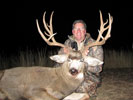 J & J Outfitters
J & J Outfitters
Offering quality fair-chase hunts for trophy mule deer, elk, shiras moose and mountain lions.
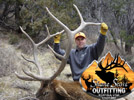 Shane Scott Outfitting
Shane Scott Outfitting
Quality trophy hunting in Utah. Offering FREE Utah drawing consultation. Great local guides.
 Utah Big Game Outfitters
Utah Big Game Outfitters
Specializing in bighorn sheep, mule deer, elk, mountain goat, lions, bears & antelope.
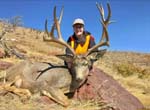 Apex Outfitters
Apex Outfitters
We offer experienced guides who hunt Elk, Mule Deer, Antelope, Sheep, Bison, Goats, Cougar, and Bear.
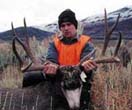 Urge 2 Hunt
Urge 2 Hunt
We offer high quality hunts on large private ranches around the state, with landowner vouchers.
 Allout Guiding & Outfitting
Allout Guiding & Outfitting
Offering high quality mule deer, elk, bear, cougar and bison hunts in the Book Cliffs and Henry Mtns.
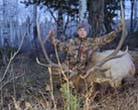 Lickity Split Outfitters
Lickity Split Outfitters
General season and LE fully guided hunts for mule deer, elk, moose, antelope, lion, turkey, bear and coyotes.

